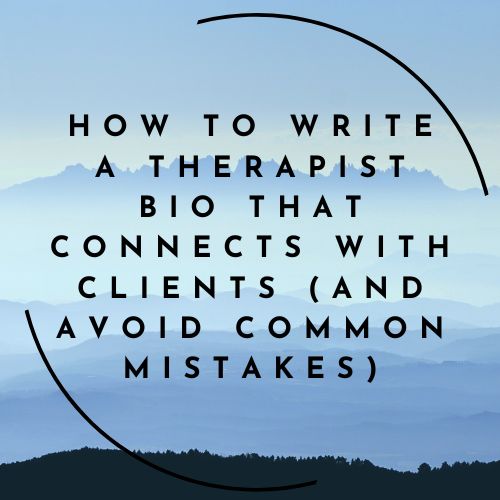Your therapist bio is one of the most visited pages on your website, often second only to your homepage. A potential client lands on your site, skims through your services, and then clicks on your bio to answer one critical question:
“Do I feel comfortable reaching out to this therapist?”
A well-crafted therapist bio can build trust, establish an emotional connection, and encourage a potential client to take the next step. However, many bios fall into common pitfalls:
❌ Too clinical or impersonal – Overloading your bio with credentials, acronyms, and therapy jargon can feel cold and distant.
❌ Lack of client focus – Many bios center the therapist instead of addressing the client’s struggles and how therapy can help them.
❌ Overly formal or robotic language – Clients want to connect with a real person, not read something that sounds like a resume or academic paper.
If your bio isn’t written with a client-first approach, it could be costing you potential inquiries. Let’s break down how to write a therapist bio that truly connects and inspires people to reach out.
Learn More About My Writing Services for Therapists
Step 1: Start With a Warm, Engaging Opening
Your first few sentences set the tone for your entire bio. Rather than jumping straight into your credentials or theoretical orientation, start with a statement that speaks directly to your ideal client’s experience.
Examples of Strong Opening Lines:
✅ “If you’re feeling overwhelmed by anxiety, stuck in old patterns, or unsure how to move forward, you’re not alone. I help people like you find clarity, healing, and a greater sense of ease in daily life.”
✅ “Navigating life’s challenges can feel isolating, but you don’t have to do it alone. I provide a warm, supportive space to explore what’s holding you back and help you move toward meaningful change.”
These openings immediately acknowledge the client’s experience, making them feel seen and understood.
Common Mistake:
❌ Starting with credentials instead of connection.
🚫 “I am a Licensed Clinical Social Worker with 12 years of experience in cognitive behavioral therapy (CBT) and dialectical behavior therapy (DBT).”
✔ While credentials are important, leading with them can feel impersonal—save them for later in your bio.
Step 2: Describe How You Help Clients (In a Way They Understand)
This is where you introduce your therapeutic approach, but in a way that centers the client’s needs instead of focusing solely on theory.
Better Approach:
- Describe how your approach benefits the client rather than just listing modalities.
- Use conversational, accessible language instead of clinical terminology.
- Help clients imagine what therapy with you feels like.
✅ “I take an integrative approach to therapy, using evidence-based techniques like cognitive behavioral therapy (CBT) and mindfulness to help clients manage stress, shift unhelpful thought patterns, and develop healthier coping strategies.”
✅ “My approach is warm, interactive, and tailored to your unique needs. Together, we’ll explore the challenges you’re facing and uncover practical solutions that align with your values and goals.”
Common Mistake:
❌ Listing too many modalities without explaining how they help.
🚫 “I use CBT, DBT, ACT, and psychodynamic approaches to treat anxiety, depression, and trauma.”
✔ Instead, briefly describe what therapy with you looks like in a way that resonates with potential clients.
Step 3: Share a Personal Touch (Without Oversharing)
Adding a human element to your bio makes you more relatable and approachable. A brief sentence or two about why you became a therapist or what you enjoy outside of work can help clients feel connected to you as a person.
Examples of Authentic Personal Touches:
✅ “My journey into therapy started with my own curiosity about how people grow and heal. I love helping clients uncover their strengths and move toward a more fulfilling life.”
✅ “Outside of therapy, I enjoy hiking, reading, and spending time with my dog, Luna. I believe that finding joy in everyday moments is an essential part of healing.”
Common Mistake:
❌ Oversharing personal struggles in a way that shifts focus away from the client.
🚫 “I struggled with anxiety for years before becoming a therapist, and I still deal with it today.”
✔ A little personal detail is great, but your bio should focus on the client, not your own therapy journey.
Step 4: Include a Clear Call to Action (Encourage Next Steps!)
Even if a potential client connects with your bio, they won’t automatically reach out—they need a clear invitation to take action.
Examples of Effective Calls to Action:
✅ “If you’re ready to start your therapy journey, I’d love to support you. Click here to schedule a free consultation.”
✅ “Finding the right therapist is important. If you have any questions, feel free to reach out—I’m happy to help.”
This simple step removes uncertainty and encourages clients to take action.
Common Mistake:
❌ Ending the bio without a clear next step.
🚫 “I look forward to working with you.”
✔ A strong call to action increases the likelihood that clients will reach out instead of clicking away.
Final Checklist: Does Your Therapist Bio Include These Essentials?
✅ A warm, engaging introduction that connects with your ideal client
✅ A clear, accessible description of how therapy with you helps clients
✅ A personal touch that makes you relatable
✅ A call to action that encourages potential clients to reach out
Your bio isn’t just an informational section of your website—it’s one of the most powerful tools for converting visitors into clients.
Need a Professionally Written Therapist Bio?
A great therapist bio can make the difference between a potential client booking a session or clicking away. If you want a compelling, client-centered bio that reflects your authentic voice and expertise, I can help.
Learn More About My Writing Services for Therapists

